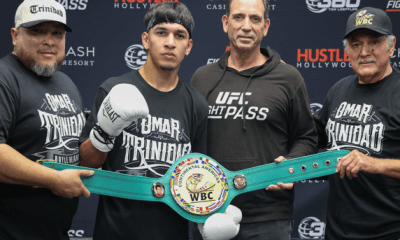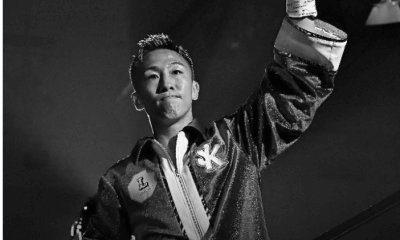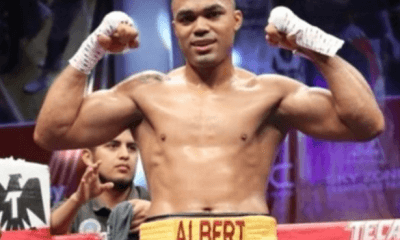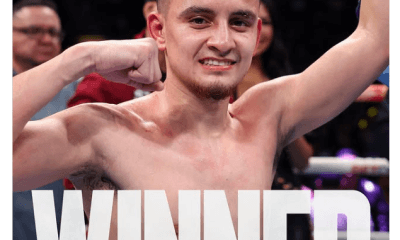Book Review
Literary Notes from Thomas Hauser (Book Reviews)
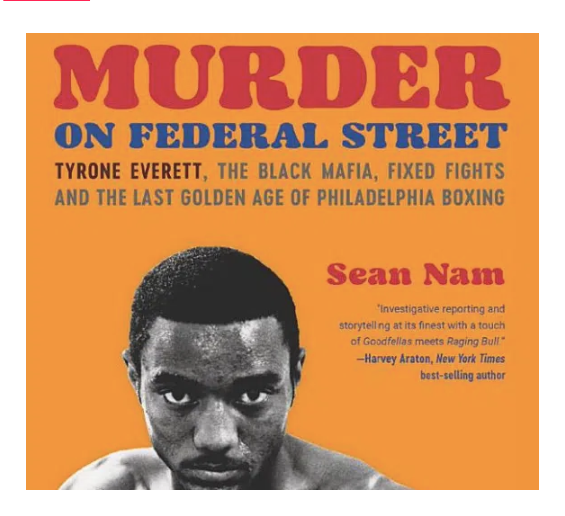
Literary Notes from Thomas Hauser (Book Reviews)
Tyrone Everett was a stylish southpaw who preferred boxing to slugging which made him the antithesis of the typical Philadelphia fighter. Russell Peltz (who promoted Everett for much of the fighter’s ring career), observed, “He wouldn’t lose a round. But it got monotonous because he wouldn’t take chances.” Philadelphia boxing writer Tom Cushman noted that Everett fought “with uninterrupted caution.”
That ring style made Everett a hard sell. But he was always in shape. He could crack when he set down on his punches. And he was good enough to have a future in boxing when he was shot to death at age twenty-four.
Murder on Federal Street by Sean Nam (Rushcutters Bay Books) recounts Everett’s life and death.
Everett turned pro in 1971 and had a 34-0 ring record with 18 knockouts when he challenged Alfredo Escalera for the World Boxing Council 130-pound title on November 30, 1976. The 16,019 fans in attendance at The Spectrum that night set a record that still stands for the largest indoor attendance ever for a fight in Philadelphia.
The consensus among knowledgeable ringside observers was that Everett won at least eleven of the fifteen rounds, probably more. But Ismael Wiso Fernandez (who, like Escalera, was from Puerto Rico) scored the bout 146-143 for his countryman. And in a shocker, Philadelphia judge Lou Tress turned in a 145-143 scorecard in Escalera’s favor.
As recounted by Nam, the scoring reeked of mob influence. When Harold Lederman compiled a list of the twelve worst decisions in boxing history, Escalera-Everett headed the list. “This was just highway robbery,” Lederman declared. “By far the worst decision I ever saw.”
Everett fought twice more after the loss to Escalera, knocking out two sub-.500 opponents. The second of those contests (against Delfino Rodriguez) was on the undercard of Muhammad Ali vs. Alfredo Evangelista in Landover, Maryland. He was shot and killed ten days later, on May 26, 1977.
As for the specifics of the crime; Everett was killed by a single bullet that entered his head through a nostril. The shot supposedly was fired by a woman named Carolyn McKendrick, who claimed that Everett had physically abused her in the past and was threatening to beat her again when she pulled the trigger. The murder occurred in McKendrick’s apartment but the murder weapon was never found. McKendrick was tried for the crime, found guilty of third-degree murder (intent to inflict bodily injury without intent to cause death), and sentenced to five years in prison. The fact that she was the estranged wife of druglord Ricardo McKendrick and that 39 packets of heroin were found in the apartment where Everett was killed lent credence to the theory that more than self-defense might have been involved and that Carolyn McKendrick might not even have been the killer.
And oh yes! A transvestite named Tyrone Price (who admitted to dealing drugs that he said he got from Everett and McKendrick) testified at trial that he’d been in the apartment at the time of the shooting. That provided more tabloid fodder.
Nam writes smoothly. Structurally, the book would have been better served and Everett’s life would have been seen in context more clearly if material about the “Black Mafia” in Philadelphia had been integrated throughout the story rather than tacked on in fifty pages at the end of the narrative. But Murder on Federal Street is a good slice-of-life story about Tyrone Everett and boxing in the 1970s in Philadelphia.
* * *
Eight years ago, William Detloff authored Ezzard Charles: A Boxing Life. His latest book – Matthew Saad Muhammad: Boxing’s Miracle Man (McFarland & Company) – spotlights another champion.
Detloff has thoroughly researched his subject. And there are places where he writes evocatively about the sweet science. “Money makes the world go ’round,” he notes. “But there’s not enough of it in the world to pull a man off the canvas when he’s fallen face first or to make him keep punching through a waterfall of blood and bone-deep exhaustion. That comes from somewhere else, some place deep and feral where money has no meaning.”
But Matthew Saad Muhammad: Boxing’s Miracle Man has more fight reports than needed. There are places where it’s not as nuanced as Detloff’s knowledge of boxing might have enabled it to be. And Detloff had a mountain in front of him that was hard to climb.
Ezzard Charles: A Boxing Life was the first credible biography of Charles. As such, it constituted a significant contribution to boxing history. But last year, Tris Dixon authored Warrior: Matthew Saad Muhammad (Pitch Publishing). Certain fighters are worthy of more than one biography, and Saad Muhammad is one of them. That said; Dixon’s book is simply better.
But let’s give the last word to Detloff, who writes of Saad Muhammad, “It must be remembered that, for a time, Matt lived a princely life, traveling the world, bedding beautiful women, making millions, hearing crowds chant his name. The graveyards are full of men who would have given anything to live for one day the way he did from, say, 1978 to early ’81. There are few if any times in the life of an average man when he is able to incite the passions of thousands by virtue of his will. One does not let such moments pass unacknowledged.”
* * *
No one has written about boxing’s early gloved champions in greater detail than Adam Pollack. The Iowa attorney has authored in-depth biographies of John L. Sullivan, James Corbett, Bob Fitzsimmons, James Jeffries, Marvin Hart, Tommy Burns, Jack Johnson, and Jack Dempsey. Only Jess Willard is missing from the list. And Pollack covered Willard at length in his biographies of Johnson and Dempsey.
Pollack’s latest offering is the second of what will be three volumes devoted to Dempsey. This one covers the years 1919 through 1923. Like Pollack’s earlier works, it’s meticulously researched, a bit on the heavy side, and an invaluable resource for boxing historians.
Pollack has lived with boxing’s early gloved champions in his head for decades. Which of the fights that he has written about to date would he most like to have been at?
“That’s a tough one,” Pollack answers. “I’d want a fight that was awesome at ringside and one that I’ve never seen footage of. We have some film of Johnson-Jeffries. The same for Dempsey-Willard. If you put a gun to my head, I’d say Sullivan against Jake Kilrain. It wasn’t boxing as we know it today. But there’s no film footage of Sullivan fighting. And to be in that moment in Richburg, Mississippi, seventy-five rounds, more than two hours. Yeah; that would have been special.”
And which gloved champion that Pollack has written about so far would he most like to go back in time to interview?
“For an extended interview, I’d say Jack Johnson,” Pollack answers. “For one question, I’d say Dempsey. Did he throw the Jim Flynn fight [KO by in the first minute of round one]? There’s no film of that fight. But the more I read, the more I lean toward the conclusion that Dempsey threw the fight. He was dirt poor and I don’t think ethics were his number-one concern at the time.”
Thomas Hauser’s email address is thomashauserwriter@gmail.com. His most recent book – In the Inner Sanctum: Behind the Scenes at Big Fights – was published by the University of Arkansas Press. In 2004, the Boxing Writers Association of America honored Hauser with the Nat Fleischer Award for career excellence in boxing journalism. In 2019, Hauser was selected for boxing’s highest honor – induction into the International Boxing Hall of Fame.
To comment on this story in the Fight Forum CLICK HERE
-

 Featured Articles3 weeks ago
Featured Articles3 weeks agoThe Hauser Report: Zayas-Garcia, Pacquiao, Usyk, and the NYSAC
-

 Featured Articles2 weeks ago
Featured Articles2 weeks agoOscar Duarte and Regis Prograis Prevail on an Action-Packed Fight Card in Chicago
-

 Featured Articles1 week ago
Featured Articles1 week agoThe Hauser Report: Cinematic and Literary Notes
-

 Book Review3 days ago
Book Review3 days agoMark Kriegel’s New Book About Mike Tyson is a Must-Read
-

 Featured Articles4 weeks ago
Featured Articles4 weeks agoManny Pacquiao and Mario Barrios Fight to a Draw; Fundora stops Tim Tszyu
-

 Featured Articles3 weeks ago
Featured Articles3 weeks agoArne’s Almanac: Pacquiao-Barrios Redux
-

 Featured Articles2 weeks ago
Featured Articles2 weeks agoRemembering Dwight Muhammad Qawi (1953-2025) and his Triumphant Return to Prison
-
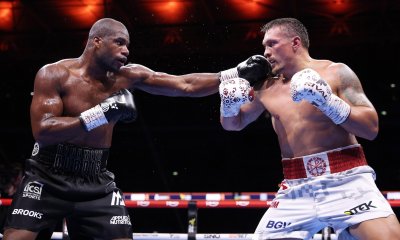
 Featured Articles4 weeks ago
Featured Articles4 weeks agoOleksandr Usyk Continues to Amaze; KOs Daniel Dubois in 5 One-Sided Rounds


